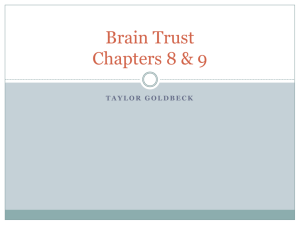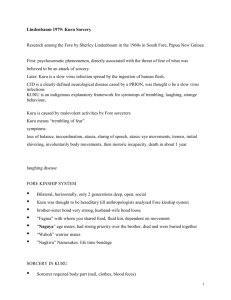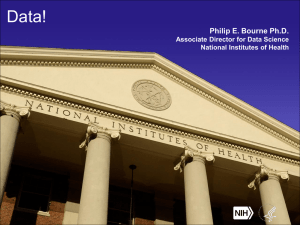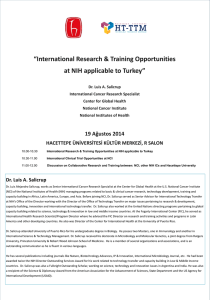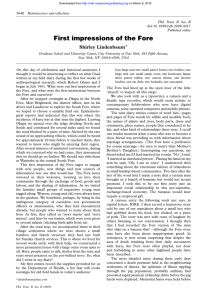CJD (because Zigas hadn`t heard of it, so we should!) 2 doctor
advertisement
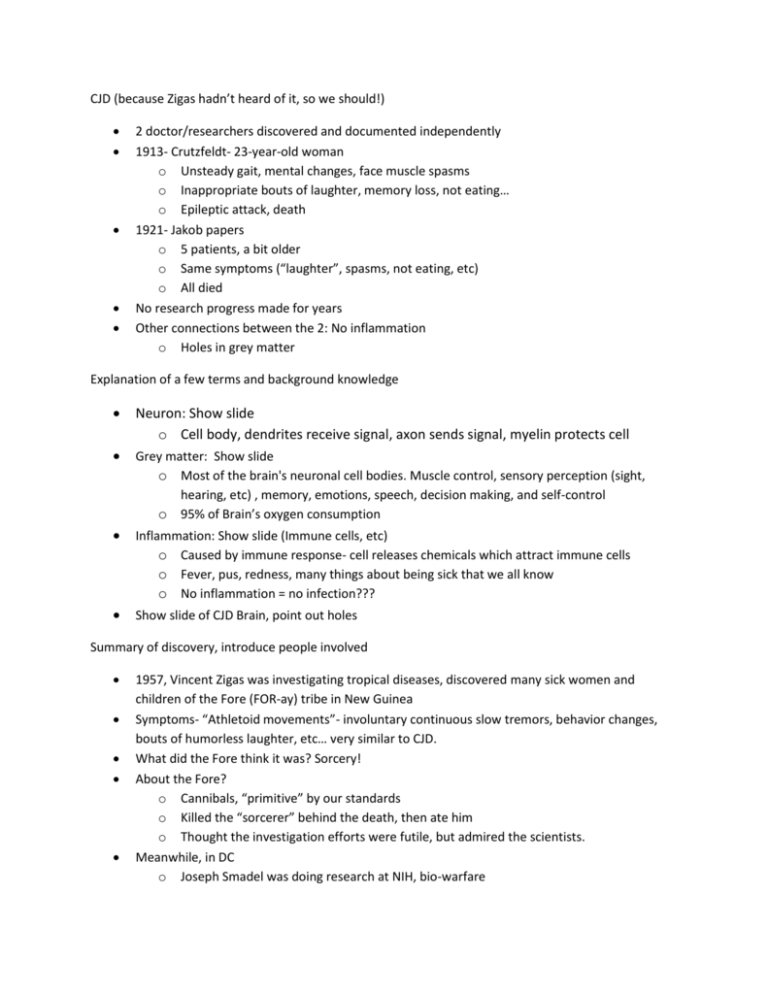
CJD (because Zigas hadn’t heard of it, so we should!) 2 doctor/researchers discovered and documented independently 1913- Crutzfeldt- 23-year-old woman o Unsteady gait, mental changes, face muscle spasms o Inappropriate bouts of laughter, memory loss, not eating… o Epileptic attack, death 1921- Jakob papers o 5 patients, a bit older o Same symptoms (“laughter”, spasms, not eating, etc) o All died No research progress made for years Other connections between the 2: No inflammation o Holes in grey matter Explanation of a few terms and background knowledge Neuron: Show slide o Cell body, dendrites receive signal, axon sends signal, myelin protects cell Grey matter: Show slide o Most of the brain's neuronal cell bodies. Muscle control, sensory perception (sight, hearing, etc) , memory, emotions, speech, decision making, and self-control o 95% of Brain’s oxygen consumption Inflammation: Show slide (Immune cells, etc) o Caused by immune response- cell releases chemicals which attract immune cells o Fever, pus, redness, many things about being sick that we all know o No inflammation = no infection??? Show slide of CJD Brain, point out holes Summary of discovery, introduce people involved 1957, Vincent Zigas was investigating tropical diseases, discovered many sick women and children of the Fore (FOR-ay) tribe in New Guinea Symptoms- “Athletoid movements”- involuntary continuous slow tremors, behavior changes, bouts of humorless laughter, etc… very similar to CJD. What did the Fore think it was? Sorcery! About the Fore? o Cannibals, “primitive” by our standards o Killed the “sorcerer” behind the death, then ate him o Thought the investigation efforts were futile, but admired the scientists. Meanwhile, in DC o Joseph Smadel was doing research at NIH, bio-warfare o Protégé Carleton Gajdusek was researching, collecting samples of tropical diseases Gajdusek met Zigas and his patients o They made a hospital to care for patients while traveling to map the epidemiology Things they noticed? o Restricted to the Fore people o Once infected, the symptoms were not changed by leaving. So, probably not a nutritional problem or a poison Finally did brain autopsy- First sent to Australian government (more on them later or now?), next 6 sent to NIH in summer 1957 Igor Klatzo examined the tissues. Findings? SHOW SLIDES o Cerebellum damage, similar to Alzheimer’s o Brain lesions similar to CJD- show slide of comparison o Kuru lesions more pronounced o About ½ of cases: “plaques” of large fibers- similar to Alzheimer’s Why was this weird? o Both rare in the West- what is special about this tribe? Both published papers in 1957, and Gajdusek started a travelling exhibit to get more attention… To be continued! The people Alois Alzheimer- 1864-1915, well-known German psychiatrist and neuropathologist. “Presenile dementia”. Colleague Emil Kraepelin later named the disease Alzheimer’s. One 51-year-old patient in 1901 had memory loss and other strange symptoms, became an obsession. Discovered plaques in the brain upon autopsy. Hans Gerhard Creutzfeldt- 1885-1964, Worked in Alzheimer’s clinic. Psychiatrist and neurologist. Fun fact, during WWII he was able to save most of his patients from the euthanasia of mental patients that the Nazis were doing. Alfons Maria Jakob- 1884-1931, Also worked in Alzheimer’s clinic/lab. Professor of neurology/neuropathology. First to recognize and describe CJD. Fun fact: Also studied concussions, MS, and neurosyphilis. Vincent Zigas- Doesn’t have a Wikipedia page, seems to have been overshadowed by Gajdusek! (What about him made him a good scientist to be working on this?) He was a very genuine/sincere person, and earned the respect of the Fore so that he could start bringing his patients to a hospital away from the tribe. He worked hard to get the government interested, and when they turned him down he worked with Gajudsek. Daniel (D) Carleton Gajudsek- 1923-2008, “James Bond”-type person. Able to work in many foreign countries, adept language skills, “genius”, had connections. Won the Nobel Prize in 1976 for his kuru work. Traveled around the world collecting samples of dangerous agents for study at NIH. He could travel long distances tirelessly and was great at communicating both with natives and the press. Fun fact: convicted of child molestation in 1996. IMO, he was the best possible person to work on something like this. Joseph Smadel- 1907–1963, infectious disease (Biowarfare) researcher at Army/NIH. “M” to “James Bond”- the one with the money and the reputation. He went along with Gajudsek’s crazy ideas and was interested in global disease. He studied mosquitoes and flavivurises (West Nile, for ex), and polio vaccines. Book mentions conflict with virus in vaccine causing cancer and that he was pressured to cover it up. Fun fact: became director of NIH in 1955. Igor Klatzo- 1916-2007, Neuropathologist who studied the first brain autopsy. He was the first to make the connection between CJD and kuru. Yabaiotu- First woman who’s brain was autopsied. (I think she’s important!) Australian Government/Press Nonresponsive to initial pleas from help from Zigas… unknown tropical disease, right? Later, mad at all the US intervention, demanded first brain be sent to them instead of back to NIH o This is the most frustrating thing I read here… how do you feel about it? Press loved the new disease and Gajudsek… called it the “Laughing Death” o Is this a good thing or a bad thing? o Is publicity good for impact or does the misnomer make a reader underestimate how bad this disease is? o Weird Laughing Death Hits In New Guinea's Highlands. Twenty New Guinea natives afflicted with the kuru — laughing disease—are laughing themselves to death in Okana Hospital, in the eastern highlands of New Guinea. Sir Macfarlane Buruet, director of the Walter and Kcllza Hall Institute for Medical Research In Melbourne, says the grim disease probably inherited. It is one of the' world's rarest and almost always is fatal. So far 10 natives are afflicted with kuru. An Okana Hospital official said the walls there shake from time to time with hysterical outbursts of laughter. "Some of the 10 victims already are laid down to die, after exhausting themselves with laughter. Soon they'll be paralyzed and die." The official said he had been told there is one village In the highlands "packed with laughing men and women." The disease was discovered by an American, Dr. Carleton Gajdusek, who recently spent 15 months in the Hall Institute. SLIDE Conflict that the book doesn’t mention o Was cannibalism still being practiced? Some say no, it had been stopped earlier than the kuru studies, and that the reports were very racist/sexist. o William Arens, anthropologist o Many accounts concur with the cannibalism, though, and it seems to make sense. o Robert Klitzman, S. Lindenbaum, R. Glasse


